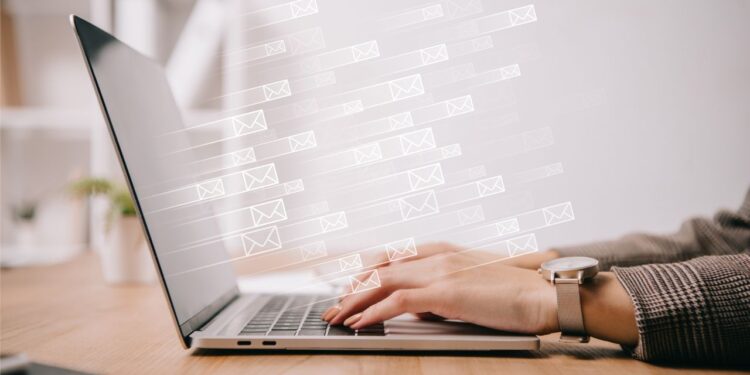- Email clutter is a common phenomenon; most workers report thousands of unread emails in their inboxes. Research shows physical office clutter and the blurred lines between home and office for remote workers have adverse effects.
- Email clutter and over-accessibility (from email apps on smartphones) contribute to worker burnout and stress.
- Strategies to reduce this stress can include deleting email apps from smartphones, managing inbox size, and unsubscribing from outside email sources.
Email clutter and perpetual access to messages are the norm for nearly everyone.
Unfortunately, this unrelenting chaos invades work inboxes, too; it is not uncommon for work or business-important emails to fall by the wayside.
According to Mailbird’s Email Overload Survey, 40% of workers receive roughly 61-100 emails every day, but only around 10% of them have any relevance to their workload.
As a result, critical work-related emails can be hard to find. One third of workers surveyed said they need to spend three to five hours per week managing their email inboxes — 39% say they spend more than six hours per week managing emails.
When workers have to spend considerable time digging through their inboxes to find relevant emails, it becomes frustrating and time-wasting. Workers could undoubtedly spend six-plus hours each week doing more productive and meaningful activities.
No escape from email stress
It is evident from Mailbird’s research that part of the stress related to work emails comes from their perpetual accessibility through smartphones.
Before the internet, emails and smartphones, time outside of work hours was typically a break from seeing work-related materials. It was customary to associate that time with intrinsically reducing stress levels.
Things are much more complicated than that now because of constant access to emails on smartphones, which most people carry with them all day.
For example, if a few hours go by without checking emails, most workers (71.1%) will not become stressed. However, that lowers to just half (51.6%) when workers ignore emails for a whole weekend; and a mere 15.6% when a week has passed with neglecting emails.
In other words, there is a strong correlation between the duration of time workers do not look at their work-related emails and stress levels.
This type of correlation is not unique to the age of modern technology. For example, Friedrich Nietzsche’s philosophy from the late 19th century suggests that it is an essential attribute of human nature to become uneased by such inactivity from work.
Constant email access has amplified this correlation of stress and inactivity with work; 48.8% of workers rank missing out on critical work-related emails as the deepest concern in relation to stress from not checking emails.
However, this problem is essentially tied to workers’ cluttered emails.
Organize and eliminate to decrease stress
Here are two strategies to cope with cluttered email inboxes and lower stress.
1. Deleting work-related apps
The first strategy worth considering is deleting all work-related materials from your phone and letting others at work know you’ve done so.
“It is stressful to feel the need to check all the time.”
Saying something like this will get others to understand and respect your choice in most workspaces; work-related emails are rarely important enough that they cannot wait until workers are in the office during work hours to see them.
When you’ve established such a norm with yourself and your colleagues, the exterior standard of needing to check emails outside of work hours will likely have less of an influence and, therefore, will produce less stress.
2. Managing email inbox size and inputs.
In some workspaces, however, constant contact is non-negotiable. In these and all other cases, managing email inbox size and inputs is critical. However, spending several hours a week doing so is untenable and needs a viable and widely applicable alternative.
Of the respondents in Mailbird’s report, 60% said that unsubscribing from unnecessary, irrelevant, or unread newsletters or email marketing campaigns helped them to manage inbox size successfully, whereas 49% say email filters are the favorite practices for email management.
Getting at the sources of most incoming emails — social media, marketing campaigns, subscriptions, spam, industry news, etc. — and eliminating those that are unnecessary is crucial to managing email size.
Determining which are necessary can be a challenge for many workers, as 73% say there is no formal sense of which emails are work-crucial and which are not. Consulting with managers and coworkers may help resolve ambiguities on priorities.
Once that has been accomplished, deleting the excess may be time-consuming, and companies could consider investing in email cleaning software that can streamline this entire process, thus making it all the less stressful for workers.


 Dr. Gleb Tsipursky – The Office Whisperer
Dr. Gleb Tsipursky – The Office Whisperer Nirit Cohen – WorkFutures
Nirit Cohen – WorkFutures Angela Howard – Culture Expert
Angela Howard – Culture Expert Drew Jones – Design & Innovation
Drew Jones – Design & Innovation Jonathan Price – CRE & Flex Expert
Jonathan Price – CRE & Flex Expert













